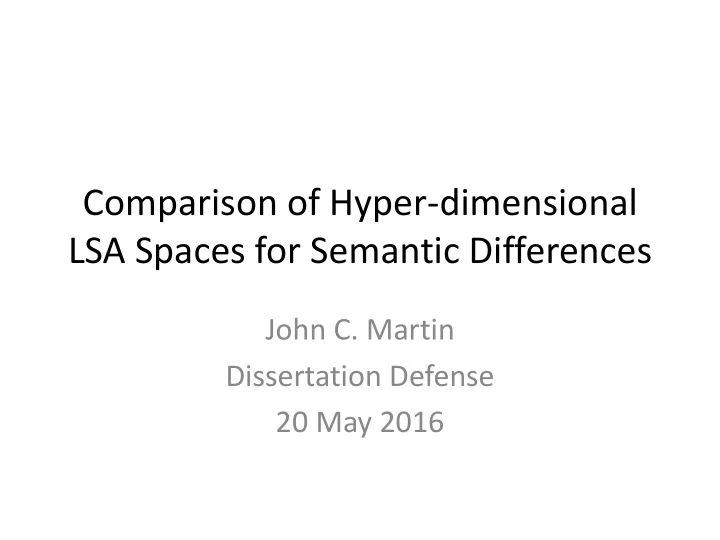

Comparison of Hyper-dimensional LSA Spaces for Semantic Differences John C. Martin Dissertation Defense 20 May 2016
Overview • Review LSA model of learning – What is meaning? • Measures • Experiments • Semantic Measurement Model • Q & A
The LSA Model of Learning Orthogonal Axes Dimensionality Reduction Mapping System Meaning
Compositionality Constraint The meaning of a document is the sum of the meaning of its words 𝑟 𝑈 𝑉 𝑙 D = 𝑙
Compositionality Constraint Corollary The meaning of a word is defined by the documents in which it appears (and does not appear)
Meaning The Mapping system consists of: Term Vector Dictionary Singular Values
Motivation
Objective Find a measure or set of measures that can quantify the difference between two spaces
Measures • Direct Comparison • Projected Content Comparison • Rotated Item Comparison
Direct Comparison Measures 2 1 2 1 3 3
Individual Space Measures • Document Count • Term Count • Non-zeroes
Distribution Analysis
Term and Document Overlap
Projected Content Comparisons 2 Matched items 1 3 projected into each space 1 2 3
Projected Item Distribution
Three-Tuple Comparisons 𝐵, 𝐶, 𝐷 𝐵 = 𝑞 𝑗 , 𝐶 = 𝑞 𝑘 , 𝐷 = 𝑞 𝑙 , where 𝑗 ≠ 𝑘 ≠ 𝑙, ∀𝑞 ∈ 𝑄
Three-Tuple Relationship Changes
Rotations and Transform Comparisons 2 1 3 2 1 3 2'
The Transform 𝐵 1 = 𝑄𝑠𝑝𝑘𝑓𝑑𝑢(𝐵, 𝑇 1 ) 𝐵 2 = 𝑄𝑠𝑝𝑘𝑓𝑑𝑢(𝐵, 𝑇 2 ) 𝑈 𝐵 2 = 𝑉 𝑊 𝑈 𝐵 1 𝑅 = 𝑉𝑊 𝑈 𝐵 1 𝑅 − 𝐵 2 𝐺
Comparative Space Centroid Analysis C 1 C 2 C 1 C 2
Overlapping Term Vector Norm 𝑈 𝑙 2 𝑈 1 𝑅 − 𝑈 2 𝐺 = 𝑈 𝐺 = 𝑢 𝑗,𝑘 𝑗=1 𝑘=1
Projection/Anchor Sets Unique Term Set Documents Terms Instances NICHD04 1,060 5,912 70,063 T-500 500 16,317 123,668 T-1000 1,000 24,319 252,372 T-5000 5,000 49,995 1,281,749
Control Experiment
General Experiment
General Experiment
Grade Level Series Experiment
Grade Level Series OTV-Norm
Large Volume Experiment
Large Volume Experiment
Non-overlapping Series Experiment
Non-Overlapping Series OTV-Norm
Frozen Vocabulary Experiment
OTV-Norm
Semantic Measurement Model 𝑈𝐷% ≈ −0.207882 + 0.0507194 𝑃𝑈𝑊𝑂𝑝𝑠𝑛 + −0.339339(𝑈𝑃𝑆)
Summary of Contributions • Semantic differences are observable – Measurable – Quality based • Similarity not dependent on overlapping content • OTV-Norm & Semantic Measurement Model – Whole-space measurement
Further Research • Refine the model – Anchor set selection/influence – Account for non-overlapping terms – Investigate non-linear model • Other questions raised
Leverage for Answering Other Questions Is it possible to identify key documents that affect the meaning of a space? Do additional items added to a space have any impact? Is there a point at which adding any items to a space makes no difference? Is it possible to identify necessary knowledge that would align two spaces?
Q&A
Backup Slides
Projection of New Content Mapping Information 2 LSA Text 1 Space Sources 3 Projection 1 2 3
Data • 42 Spaces • 592 Comparisons • 4 Projection Sets • 4 Anchor Sets • 26 Measures 61,568 Data Items Collected
Distribution Analysis
Recommend
More recommend